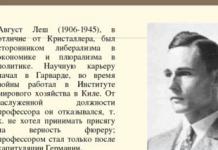V. Kristaller calls central places economic centers that provide goods and services not only to themselves, but also to the population of their surroundings (sales zones). According to V. Christaller, over time, service and sales areas tend to form into regular hexagons (honeycomb), and the entire populated area is covered with hexagons without gaps (Crystaller lattice). This minimizes the average distance for product distribution or travel to centers for purchases and services. V. Christaller's theory explains why some goods and services should be produced (provided) in every settlement (essential products), others - in medium-sized settlements (ordinary clothing, basic household services, etc.), others - only in large cities (luxury goods, theaters, museums, etc.)
The type of hierarchy is determined by the number of central places at a given level. The number of subordinate central places, increased by one, is denoted by the letter K. Any center always has the same number of settlements dependent on it, occupying a lower level.
Let us consider, for example, the case where there is a three-level hierarchy of settlements: city - town - village. Then, with K = 7, there will be 6 villages around each city, and 6 villages around each village, i.e. There will be only 6 towns and 36 villages around the city. With a four-level hierarchy (city - town - settlement - village), around the city there will be 6 towns, 36 settlements and 216 villages, etc. The general formula for reflecting this dependence is as follows:
Mn =(K − 1)n ,
where Mn is the number of dependent places at one or another degree of hierarchy; n - level of hierarchy.
In principle, there can be any number of possible hierarchy types. However, V. Christaller and his followers paid the greatest attention to the analysis of three types, or variants, of the hierarchy at K = 3, 4, 7. These variants of the hierarchy of settlement systems are interpreted as follows.
The option with K = 3 provides the optimal configuration of market zones (territories whose population purchases goods and services in a given central location). Service of the territory is achieved by the smallest possible number of central places. In this case, each central place is served by three central places of the next higher level of the hierarchy and is located at equal distances from them.
The option with K = 4 creates the best conditions for the construction of transport routes, since in this case the largest number of central places will be located on one highway connecting larger cities, which will ensure minimal costs for road construction, i.e. a given central location will be at the shortest distance to the two nearest centers of a higher level of hierarchy.
The option with K = 7 seems appropriate if strict administrative control is required. In this case, all central places dependent on a given place are completely included in its zone.
Zipf's rule.
Zipf's rule("rank-size") - a model for calculating the population of any city in the country (hierarchy of cities). If the territory is an integral economic region, then the population of the nth largest city is 1/n the number of residents of the largest city.
That is, 1/2 of the population of the 1st lives in the 2nd city, 1/3 - in the 3rd, 1/4 - in the 4th, etc.
World cities.
World City is a city considered an important element of the global economic system. Such a city is of key importance for large regions of the Earth and has a serious political, economic and cultural impact on them. Most often they differ from the intrastate periphery.
They are divided into 3 classes: alpha (New York, London, Paris, Singapore, Tokyo, Hong Kong, Beijing, Milan, Sydney, Moscow), beta (Barcelona, Washington, San Francisco, Bucharest, Oslo) and gama (Panama, Vancouver, Seattle, St. Petersburg).
Description of the presentation by individual slides:
1 slide
Slide description:
2 slide

Slide description:
August Lesch (1906-1945), unlike Christaller, was a supporter of liberalism in economics and pluralism in politics. He began his scientific career at Harvard, and during the war he worked at the Institute of World Economy in Kiel. He refused the well-deserved position of professor because he did not want to take the oath of allegiance to the Fuhrer; He became a professor only after the surrender of Germany.
3 slide

Slide description:
As you move away from the main central place, the system of uniform distribution of cities in space is transformed into a structure where sectors “rich” and “poor” in settlements alternate. Economic landscape of A. Lesh: a) 12 sectors; b) centers with the largest number of functions; c) two adjacent sectors (increased; the sizes of the points are proportional to the number of functions)
4 slide

Slide description:
A city placement model that is as close as possible to the real world. A. Lesh introduced additional factors into his model, the main one of which is the central place common to all settlements in a given territory: the largest and most important city, the economic center of the entire system of settlements. Lesh's model made it possible to optimize all three structures - market, transport and administrative.
5 slide

Slide description:
Why and where do periodic central places - fairs and markets - appear? Conditions for the emergence of periodic central places. Many remote areas of less developed countries have poor infrastructure and only seasonal roads. In this case, consumers - rural residents who predominate in the population structure - cannot regularly travel for goods and services to remote cities - permanent central places. The function of supplying the population with central goods and services is performed by traveling traders. As a rule, they move from village to village, giving rise to such a widespread phenomenon as fairs, that is, periodically existing markets, or periodic central places.
6 slide

Slide description:
Transforming periodic central places into cities. As the population size and density of a territory grows, its economy develops, and incomes, standards, and consumption levels rise, the total volume of trade increases, and the frequency of fairs in a given location becomes more frequent.
7 slide

Slide description:
Repetition and generalization of knowledge on the topic Name the main provisions of Zipf's rule. What are the conditions for its implementation? List the features of the location of the real and ideal Zipf curve: for more developed countries; for less developed countries. Are they always fulfilled? Using Zipf's rule, draw conclusions about the evolution of the settlement system in our country from 1897 to 2006. What patterns does V. Christaller’s model explain? What is A. Lesch's contribution to the development of the central place model? In what areas do periodic central places appear? Explain the mechanism of their formation. What are the main methods of state regulation of settlement systems?
The first theory about the functions of placing a system of settlements (central places) in the market space was put forward by W. Christaller in his work “Central Places in Southern Germany” (1993). He substantiated his theoretical conclusions with empirical data.
Central places According to Christaller, they are called economic centers that serve goods and services not only to themselves, but also to the population of their surroundings (sales zone). Over time, service and sales areas tend to form into regular hexagons (honeycombs), and the entire populated area is covered with hexagons without gaps (Crystaller lattice, Fig. 4.4). This minimizes the average distance for product distribution or travel to centers for purchases and services.
Christaller's theory explains why some goods and services (essential products) should be produced (provided) in every settlement, others (ordinary clothing, basic household services, etc.) - in medium-sized settlements, and others (luxury goods, theaters, museums, etc.) - only in large cities.
Rice. 4.4. Placement of service areas and settlements according to the theory of V. Christaller
Each central location has a larger sales area, the higher the level of hierarchy to which it belongs. In addition to the products necessary for the zone of its rank (its hexagon), the center produces (provides) goods and services typical for all centers of lower ranks.
The type of hierarchy is determined by the number of central places at a given level. The number of subordinate central places increased by one is indicated by the letter TO. Any center always has the same number of settlements dependent on it, occupying a lower level.
Let us consider, for example, the case when there is a three-level hierarchy of settlements: “city - town - village”. Then at K = 1 There will be six villages around each city, and six villages around each village, i.e. There will be only six towns and 36 villages around the city. With a four-level hierarchy (“city - town - settlement - village”), around the city there will be six towns, 36 settlements and 216 villages, etc. The general formula for reflecting this dependence is as follows:
Where M n - the number of dependent places at one or another level of the hierarchy;
n- hierarchy level.
In principle, there can be any number of possible hierarchy types. However, V. Christaller and his followers paid the greatest attention to the analysis of three types, or options, of the hierarchy in TO= 3, 4, 7. These options for the hierarchy of settlement systems are interpreted as follows.
Option when K = 3 provides the optimal configuration of market zones (territories whose population purchases goods and services in a given central location). Service of the territory is achieved by the smallest possible number of central places. In this case, each central place is served by three central places of the next, higher level of the hierarchy and is located at equal distances from them.
Option when TO= 4 creates the best conditions for the construction of transport routes, since the largest number of central places will be located on one highway connecting larger cities, which will ensure minimal costs for road construction. That is, this central place will be located at the shortest distance to the two nearest centers of a higher level of hierarchy.
Option when K = 7 seems appropriate if strict administrative control is required. In this case, all central places dependent on a given place are completely included in its zone.
From the above examples it is clear that the functions of settlements are different, each of them has its own radius of influence and attraction. In accordance with this, different ways of territorial organization of settlement systems are possible, in which the most favorable conditions are created for the performance of certain functions. The three cases considered, corresponding to the values of the indicator TO, can be interpreted as market, transport and administrative orientations in the formation of the territorial settlement structure.
Christaller's theory of central places, although extremely abstract, allows us to formulate general ideas about expedient settlement in a particular territory. It can be considered as a theory that provides an ideal standard of a settlement system, with which the settlement systems that are developing in reality should be compared in order to identify directions for their improvement. There are also known examples of the practical application of the theory of central places to solving specific problems of territorial organization of economy and settlement in various countries.
The theory of central places was created by Walter Christaller in the early 1930s, he first tried to formulate it in his work "Central Places in Southern Germany", published in 1933, as a law of the spatial distribution of settlements around a larger "central place". Walter Christaller tried to create an abstract model of location, test it on a number of specific settlement networks in Europe and apply it in practice during the development and construction of settlements in areas that were not yet sufficiently populated. Unfortunately, this work by Christaller was never translated into Russian.
The correct location of settlements in relation to each other and the resulting analysis of the patterns of mutual placement of cities, the possibility of creating a theory that would not just describe the spatial distribution of settlements, but would also have practical significance, interested Walter Christaller back in the 1920s. When creating his theory, as Christaller himself wrote, he took the opposite path compared to Johann von Thünen, who created his theory of the spatial distribution of agriculture at the beginning of the 19th century: “He [Thünen] assumed the central city to be given and asked how the agricultural holdings around it were distributed him, while I started from a given inhabited area and then asked where the cities should be located."
V. Christaller's theory explains why some goods and services should be produced (provided) in every settlement (essential products), others - in medium-sized settlements (ordinary clothing, basic household services, etc.), others - only in large cities (luxury goods, theaters, museums, etc.)
The basic tenet of central place theory is that the location of economic activity is primarily determined by conditions of supply and demand. However, the real geographical space is extremely heterogeneous, and factors such as relief, population, and transport play a crucial role, but in order to check the influence of only supply and demand, it is necessary to simplify the remaining factors and make the assumption “all other things being equal.” For the theory of central places, this simplification is that the area is considered as a homogeneous plain with equally fertile soils, a homogeneously distributed population, characterized by the same needs and preferences. Transport accessibility in all directions is also expected. Thus, Christaller's theory of central places is based on an idealized territory, the so-called. isotropic surface. In such a territory, the costs of supplying a settlement will depend only on the distance between the place of production of the goods and this settlement. As costs increase, the demand for most goods decreases, and therefore it is obvious that as distance increases, the demand for any good in any area will decrease until a point is reached where there is no consumer for the corresponding goods and services. And since the population, in turn, is distributed evenly and transport costs are proportional to the distance, the sales zone of any product will have the shape of a circle and the place of production of this product will be located in the center of the sales zone, that is, it will become a “central place”, and all settlements that supplied from this center will be “dependent” places. As a result, if there are many cities, the entire territory will be divided into spheres of influence. The actual size of a product's distribution zone is entirely determined by the price of the product at a central location and the distance at which transport costs are still tolerable relative to the price of the product compared to the price of the same product from another central location.
Walter Christaller based his theory on the assumption that k-scores are determined based on three different principles:
- Principle 1 is the “marketing principle”, which applies to those areas where the supply of goods in central places should be as close as possible to dependent settlements. This is a system where k=3 and its derivatives. In this case, the largest possible number of central places arises.
- Principle 2 is the “transport principle”, which is applied in cases where the main thing is to take into account the costs of constructing a transport network. This is a system where k=4 and its derivatives. In this case, the largest possible number of central places will be located on one highway that connects the largest cities.
- Principle 3 is the “administrative principle”, which is applied to areas where clear administrative control over dependent settlements is necessary (k=7 and its derivatives).
The main disadvantage of centrality theory with a fixed k-score is that it assumes discontinuous differences in the demand for goods and services. The minimum threshold size for sales orientation that can be used is k=3, then k=9 and then k=21. That is, it is clear that a very strict hierarchy arises, in which settlements of a given level have the same combination of functions, and all places of higher rank contain the functions of central places of lower rank.
Walter Christaller built his doctrine of central places not on an economic-geographical scientific basis, but on a methodological behavioral basis. In his constructions, instead of production, in the first place is the behavior of man as a creature that lives according to the same principle as other organisms of ecosystems, that is, according to the principle of choice in the process of traveling the shortest distances (also time or energy) - i.e. minimizing distances.
Walter Christaller is one of the now widely known German geographers. He lived in Germany from 1893 to 1969 and made a significant contribution to geographical science thanks to the model he created for the spatial distribution of settlements - the so-called theory of central places. As Yu.G. wrote Saushkin with the name of Walter Christaller (and August Lesch) “was largely associated with the emergence of “behaviourist” geography.
This idea of hexagons in placing settlements on an ideal plain was proposed 70 years later by the German geographer W. Christaller, independently of L. Lalanne, in his theory of central places. He had three principles of spatial organization and hierarchy of the network of settlements on an anisotropic territory: 1) market with the K = 3 model; 2) transport – model K = 4; 3) administrative principle K = 7. The transport principle involves minimizing the length of the transport network, i.e. the most economical connection of all pairs of settlements.
The theory of central places was created by Walter Christaller in the early 1930s, he first tried to formulate it in his work "Central Places in Southern Germany", published in 1933, as a law of the spatial distribution of settlements around a larger "central place". Walter Christaller tried to create an abstract model of location, test it on a number of specific settlement networks in Europe and apply it in practice during the development and construction of settlements in areas that were not yet sufficiently populated. Unfortunately, this work by Christaller was never translated into Russian.
The correct location of settlements in relation to each other and the resulting analysis of the patterns of mutual placement of cities, the possibility of creating a theory that would not just describe the spatial distribution of settlements, but would also have practical significance, interested Walter Christaller back in the 1920s.
Walter Christaller was a man who adhered to relatively moderate social democratic views, as a result of which, after the arrival of Adolf Hitler in Germany in 1933, he moved to France, but not finding a means of subsistence there, he was forced to return back to Germany that same year. As a result, in 1940, Walter Christaller joined the National Socialist Workers' Party of Germany and became an employee of the SS department, which developed plans for the territorial reorganization of occupied territories in Europe, including on the territory of the USSR. After Germany's defeat in World War II in 1945, Walter Christaller joined the Communist Party. But after its ban, Walter Christaller joined the Social Democratic Party, essentially returning to those views when he developed his theory of central places.
When creating his theory, as Christaller himself wrote, he took the opposite path compared to Johann von Thünen, who created his theory of the spatial distribution of agriculture at the beginning of the 19th century: “He [Thünen] assumed the central city to be given and asked how the agricultural holdings around it were distributed him, while I started from a given inhabited area and then asked where the cities should be located."
The simplest presentation of Christaller's theory of central places is proposed in the book of Toin and Nybi "Methods of Geographical Research". The main postulate of the theory of central places is that the location of economic activity is mainly determined by conditions of supply and demand. However, the real geographical space is extremely heterogeneous, and factors such as relief, population, and transport play a crucial role, but in order to check the influence of only supply and demand, it is necessary to simplify the remaining factors and make the assumption “all other things being equal.” For the theory of central places, this simplification is that the area is considered as a homogeneous plain with equally fertile soils, a homogeneously distributed population, characterized by the same needs and preferences. Transport accessibility in all directions is also expected. Thus, Christaller's theory of central places is based on an idealized territory, the so-called. isotropic surface. In such a territory, the costs of supplying a settlement will depend only on the distance between the place of production of the goods and this settlement. As costs increase, the demand for most goods decreases, and therefore it is obvious that as distance increases, the demand for any good in any area will decrease until a point is reached where no consumer can be found for the inappropriate goods and services. And since the population, in turn, is distributed evenly and transport costs are proportional to the distance, the sales zone of any product will have the shape of a circle and the place of production of this product will be located in the center of the sales zone, that is, it will become a “central place”, and all settlements that supplied from this center will be “dependent” places. As a result, if there are many cities, the entire territory will be divided into spheres of influence. The actual size of a product's distribution zone is entirely determined by the price of the product at a central location and the distance at which transport costs are still tolerable relative to the price of the product compared to the price of the same product from another central location.
The entire study area could be divided into a number of circular zones, but a certain difficulty arises here: if the circles touch each other, then unserved territories arise, but if the circles, on the contrary, fill the entire territory, then they must intersect, resulting in overlapping zones. Therefore, the most effective shape of sales areas is the shape of a regular hexagon. Hexagon-shaped areas evenly fill the entire area.
As the principle for constructing a model for the placement of central places, Kristaller adopted the “behavioral” principle - a minimum of time, effort and means for the population of smaller settlements to achieve their central place. Solving the minimum problem led to the construction of an orthogonal (hexagonal) model: at the corners of the hexagon there are smaller settlements, and in the middle there is a larger city that serves as the central location.
Zones may vary in size depending on demand indicators.
The simplest relationships arise if the central location serves each of the nearby dependent locations. Based on the fact that there are 6 dependent zones that immediately surround the central place, it is assumed that with maximum demand for one product from any one settlement, regardless of whether it is central or dependent, each sales zone will contain seven demand units: six for dependent locations and one for central... The figure for total demand is called the “k-score” of the central place, and in the case considered is k = 7.
Consider another case where perhaps not all clientele of dependent territories are oriented towards one central location, for example, in each dependent settlement the demand may be divided between two central places. In this case, k=4, since each dependent place receives 0.5 demand units and another central place (k=6*0.5+1).
The third case is when each dependent location has the opportunity to divide its demand among three central locations that are equally available. In this case, k=3, since each of the dependent places gives 1/3 of the unit of demand and plus one central place (k=6*0,(3)+1).
The three systems discussed are the basic ones, and many other systems that can be built will be derivatives of those described. For example, a network with coefficient k=13 is derived from a network with coefficient k=7, since the total demand is satisfied by one central location.
However, goods and services can be completely different: there are goods and services that have a high price threshold, and there are goods and services that have a low price threshold. Products with a high price threshold will be sold in fewer places than products with a low price threshold. It follows that central locations that offer high-price items will be further apart than central locations that offer lower-price items. And as a result of the different combinations of goods and services offered in different places, a hierarchy of central places emerges. The nature of the hierarchy, the distribution of settlements according to their functional specialization depends not only on the variety of goods offered, but also on the k-estimates that are used in modeling settlement hierarchies.
Walter Christaller based his theory on the assumption that k-scores are determined based on three different principles:
Principle 1 is the “marketing principle”, which applies to those areas where the supply of goods in central places should be as close as possible to dependent settlements. This is a system where k=3 and its derivatives. In this case, the largest possible number of central places arises.
Principle 2 is the “transport principle”, which is applied in cases where the main thing is to take into account the costs of constructing a transport network. This is a system where k=4 and its derivatives. In this case, the largest possible number of central places will be located on one highway that connects the largest cities.
Principle 3 is the “administrative principle”, which is applied to areas where clear administrative control over dependent settlements is necessary (k=7 and its derivatives).
The main disadvantage of centrality theory with a fixed k-score is that it assumes discontinuous differences in the demand for goods and services. The minimum threshold size for sales orientation that can be used is k=3, then k=9 and then k=21. That is, it is clear that a very strict hierarchy arises, in which settlements of a given level have the same combination of functions, and all places of higher rank contain the functions of central places of lower rank.
As noted by Yu.G. Saushkin Walter Christaller built his doctrine of central places not on an economic-geographical scientific basis, but on a methodological behaviorist basis. In his constructions, instead of production, in the first place is the behavior of man as a creature that lives according to the same principle as other organisms of ecosystems, that is, according to the principle of choice in the process of traveling the shortest distances (also time or energy) - i.e. minimizing distances.
Saushkin also says that the law of mutual spatial placement of hierarchically subordinate settlements formulated by Christaller is not universal. This law is of particular importance and is valid only in countries and areas with relatively uniform settlement and the predominance of rural and semi-rural (for example, recreational) types of economy.
But no less, Christaller’s contribution to geographical science is enormous, because Christaller made an attempt to identify the law of spatial distribution of settlements. Christaller's theory of central places has taken its rightful place among other ideal models of spatial placement (Weber, Thunen, Lesch, etc.).

















